|
80x5 -
240x3 -
240x4 -
320x1 -
320x2 -
320x3 -
640x1 -
640x2
Set display option above.
Click on
images to enlarge. |
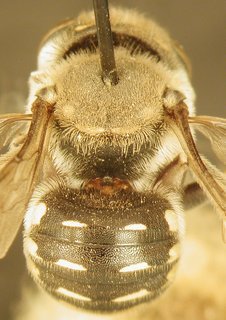
© Mary Paul
· 1
Anthidium psoraleae, female, top |
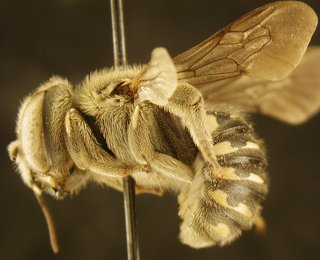
© Mary Paul
· 1
Anthidium psoraleae, female, side |
|
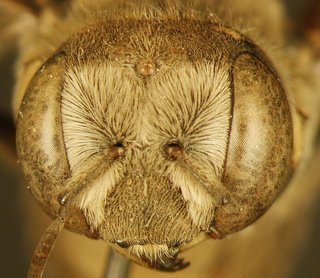
© Mary Paul
· 1
Anthidium psoraleae, female, face |
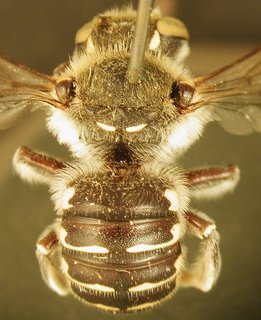
© Mary Paul
· 1
Anthidium psoraleae, male, top |
|
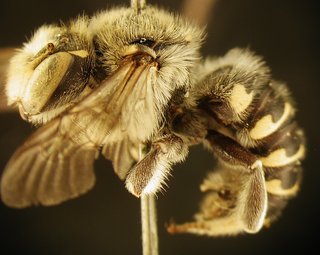
© Mary Paul
· 1
Anthidium psoraleae, male, side |
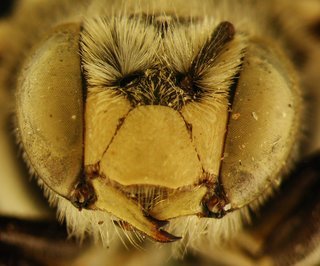
© Mary Paul
· 1
Anthidium psoraleae, male, face |
|

© Kimberly Huntzinger, 2007
· 1
Anthidium psoraleae, female, T6, VG |
|
Overview |
Reprinted with permission from: Mitchell, T.B. 1962 Bees of the Eastern United States. North Carolina Agricultural Experiment Station Technical Bulletin No. 152.
FEMALE—Length 11 mm.; black, with yellow maculations; vertex with a narrow, elongate maculation extending from each eye to posterior margin, head otherwise black; tuberdes with a very small, yellow spot, and tegu. lae with an anterior, yellow blotch; scutum black except for a narrow, marginal, yellow mark at each extreme side adjacent to tegulae; scutellum with a narrow, posterior, yellow border, this interrupted medially; thorax otherwise black; basal abdominal tergum with a pair of angular blotches on each extreme side and a pair of widely separated and quite small spots between, terga 2-5 with transverse bands that are slightly separated medially, these very narrow, becoming abruptly broadened at each extreme side except on tergum 5, tergum 6 entirely black; face considerably longer than distance between eyes above; eyes slightly convergent below; lateral ocelli sub- equally distant from eyes and margin of vertex; cheeks slightly broader than eyes; clypeus rather flat, apical margin smooth and somewhat thickened, straight except for a pair of minute denticles at each extreme side; mandibles with seven small but well developed and distinct teeth, entirely black; tegulae shining, with minute and slightly separated punctures; wings subhyaline, veins piceous; legs entirely black, basitarsi somewhat longer than following segments combined, spurs yellowish; pubescence entirely whitish, rather thin but somewhat elongate, more copious around antennae, on lower cheeks, on pleura and propodeum laterally, and on basal abdominal tergum, the ventral scopa entirely white; punctures quite deep and distinct but rather fine and close in general, densely crowded over face below antennae, on cheeks and on pleura, more distinctly separated but still close on vertex, scutum and scutellum; quite distinctly separated but still rather close on disc of basal abdominal terguni, the apical, impressed area more closely and finely punctate, discs of the following terga somewhat more closely punctate, but punctures not crowded, those on 7 densely crowded; tergum 7 triangular in outline, with a low median protuberance which is narrowly bi-dentate, and a strong, lateral angle on each side, a broad and rather deep emarginate area between these three projections.
MALE—Length 12-13 mm.; black, with yellow maculations; outer surface of niandibles, entire clypeus, lateral facial maculae ending abruptly at level of antennae, and a small maculation between upper end of eye and margin of vertex, yellow; upper portion of face, entire cheeks and antennae, black; tubercies with a very small yellow spot, and tegulae with a rather large yellow blotch, scutellum narrowly rimmed with yellow posteriorly, this interrupted medially, entire thorax otherwise black; basal abdominal tergum with rather large, angular, yellow blotches at each extreme side and a pair of widely separated, small, yellow spots between; terga 2-5 with transverse, lateral maculae which are narrowly interrupted medially, these quite narrow but abruptly broadened at each extreme side, less so on 5, 6 with a pair of small, oblique spots which are only slightly separated, 7 entirely black; face considerably longer than distance between eyes above; eyes subparallel; lateral ocelli subequally distant from eyes and margin of vertex; cheeks somewhat broader than eyes; clypeus slightly convex, only slightly broader than median length, apical margin nearly straight; mandibles distinctly 3-dentate, median tooth nearer apical tooth than to inner angle; tegulae somewhat shining, but finely and rather closely punctate; wings subhyaline, veins piceous; legs black in large part, but tibiae with apical, yellow blotches, basitarsi yellow in large part, with dense white pubescence, the more apical tarsal segments becoming piceous; spurs yellow; pubescence entirely pale, quite thin, rather elongate over head and thorax, more dense around antennae and on pleura and propodeum; punctures quite deep but rather fine and close generally, densely crowded between ocelli and antennae and on cheeks, more distinct but still close on pleura, vertex, scutum and scutellum; abdominal terga somewhat shining, punctures on disc of basal tergum rather definitely separated, the
depressed apical margin very finely and closely punctate, discs of the following terga more closely punctate, becoming crowded on 6 and 7; tergum 6 with a robust, curved spine at each extreme side; 7 with a slender, median spine, lateral margins evenly rounded, a deep emargination separating the median spine from the more truncate, lateral areas; sterna 1-5 exposed, more or less fringed apically with erect, rather elongate, pale pubescence, terga 6-8 and genital armature as shown (fig. 3).
DISTRIBUTION—Colorado and North Dakota, east to Illinois and Michigan, July. Possibly the range of this species extends to the Pacific Coast.
FLOWER RECORDS—Robertson (1929) records this species on Astragalus, Lobelia, Psoralea, Trifolium and Verbena.
|
|
|
Names | |
|
|
| Supported by | |
Updated: 2024-04-29 15:49:36 gmt
|